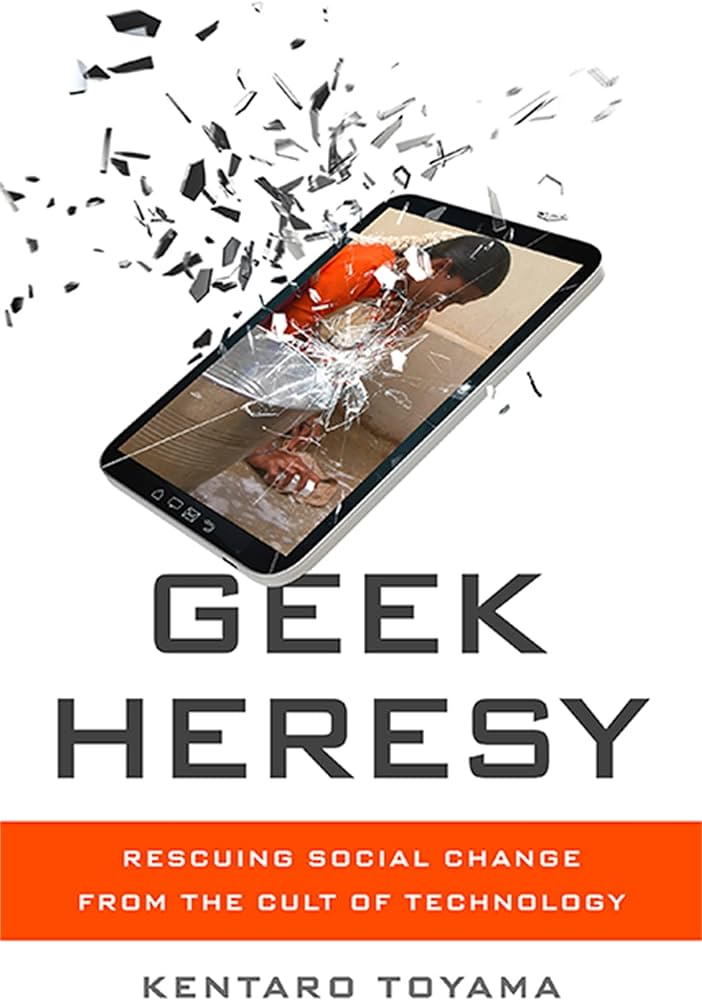[This was written a while back (late 2020 mostly), and I had posted it on a Notion page. Now consolidating all of these reviews posted elsewhere into this site.]
Book published 2015. 334 pages (main book is 218 pages; rest is bibliography and references). Read Nov’20. I purchased this book on the recommendation of Abhishek Rai about 2-3 years back but it lay unread a while.

Structure of the book
The book is divided into two parts. The first part is his critique of why social change programs and especially tech / technocratic interventions don’t work, and often end up magnifying existing inequalities. The digital rich get richer and the digital poor are left further behind. The second part describes how we can make social change programs involving tech interventions work better. A significant amount of this section concerns how we can tap into and enhance capacity at both individual and societal level via working on and enhancing and directing intentions, discernment and self-control. He refers to this troika as heart, mind and will, and says this is what technology amplifies and needs for change to take root. I suppose the core message of the book can be reduced to: “…even in a world of abundant technology, there is no social change without change in people.”
My Notes & Thoughts
I thought the book was primarily about education (perhaps Abhishek’s words positioned the book that way) and that is perhaps why I purchased it, but it is actually about how to drive social change. Education is one sector Kentaro understands well and he uses that as an arena for many of his examples.
The gist of the book is that if you are seeking to drive social change, then the packaged intervention or the technology or tool or finance has to be accompanied by a lot of ground level work to build institutions, trust, ways of work, and intrinsic capacity building in the beneficiaries, so as to absorb and best work with the tech. Else that packaged intervention will fail, or even worse amplify existing inequalities (he calls it the law of technology amplification).
Kentaro rails about what he sees as a kind of obsession that NGOs / politicians / multilateral institutions have with pushing the packaged intervention without worrying about doing capacity building or enhancing existing institutional willingness / ability on the ground, amongst the potential beneficiaries. A good example is Nicholas Negroponte saying all people need are the internet and hence a cheap laptop to students is the magic bullet. Kentaro illustrates how this and the famous Sugata Mitra example of ‘hole in the wall’ scheme all failed to generate relevant results. Kentaro says single-point solutions don’t work. We need to combine the tech with training, mentorship and ground-level interventions to make it stick and for the benefits to be reasonably widespread, and not limited to benefiting existing elites.
It is an interesting read in parts. I suppose the book is primarily aimed at social change activists, and hence it is sort of a how to guide for them to drive social change projects and initiatives. That said the book also appeals to the lay reader as it is fairly readable and has a lot of examples and descriptions, such as
- the Arab Spring revolution of 2012 which was seen as caused by Facebook; we see that it held in Tunisia, and initially Egypt, but not Saudi Arabia; because Saudi Arabia did not have any civil society for this to take root. So facebook or social media can work to instigate revolutions when the existing civil society has a certain level of capacity
- elections are seen as packaged interventions (akin to vaccines) for democracy; but in the absence of a culture of freedom of speech, strong and independent institutions such as a free judiciary, independent press etc., elections alone will not drive democracy and instead will create an erosion of trust, and lead to divides
- the inability of microcredit to take root in Mexico the way it did in Bangladesh.
Mentioned in the book, and covers
- Critique of RCTs or Randomized Control Trials
- Rikin Gandhi / Digital Green
- Ashesi University
- Critique of Microfinance / Muhammad Yunus / Grameen Bank
- Seva Mandir (also features in Poor Economics by Abhijit Banerjee + Esther Duflo)
- Failure of edtech technologies such as OLPC (One Laptop Per Child) / Hole in the Wall
Parting Thoughts
It is a decent book, and in a way happy I finished it:) But life is short; and my recommendation is that if you aren’t in the social sector / NGO space or an academic in this area, then you can safely skip it. I don’t think the juice is worth the squeeze.
I wish we could spur the publishing industry one day to creating multiple formats – one is a full-blown book like this, and the 2nd a shorter summarisation / popularisation that is written by the author or commission by the author for laypersons. HBR kind of acts as that. We perhaps need a HBR-equivalent for other non-fiction works as well. Hmm…
